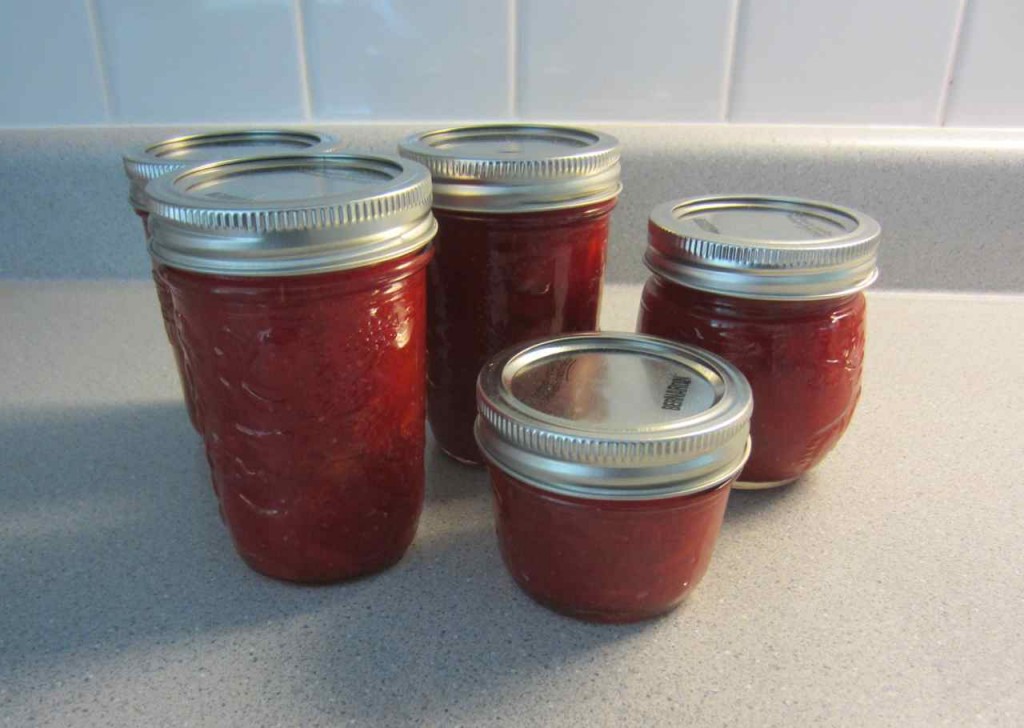 I am pretty darn pleased with myself, I must say. I’ve finally done it, all on my own. I made jam this week! Strawberry-rhubarb jam to be exact. “Tis the season for fresh strawberries, and we have lots of strawberry farms around here, so it seems only fitting.
I am pretty darn pleased with myself, I must say. I’ve finally done it, all on my own. I made jam this week! Strawberry-rhubarb jam to be exact. “Tis the season for fresh strawberries, and we have lots of strawberry farms around here, so it seems only fitting.
After years of thinking about it, believing it was very complicated, and not being brave enough to launch the Big Adventure on my own, I decided this was it. It started when a friend dropped by with some home canned jalapeño jelly and salmon (individual jars, not together).
“Hmmm, if he can do it, I’m sure I can do it.” Yes, it was a bit of sexist competitiveness creeping in. When plans fell through for him to give me a demo, I was too jazzed about the idea to just let it rest.
I kind of know the general basics from having watched my mom “put up” fruit and vegetables when I was a kid, so off I went to acquire the tools of the trade.
Canning jars are best found at local thrift stores, in my view. It nicely dovetails my obsession with mason jars and my belief in reuse/recycle whenever possible. My favourite spot is a small hospital charity run by the ladies auxiliary (I don’t even really know what that means) where they usually have plenty of jars that aren’t ridiculously over-priced (in contrast to recently observed trends at chain thrift shops; oh, don’t get me started…).I also found a small-er canning pot, ideal as (a) I won’t be putting up caseloads of preserves and (b) I live in a small space and prefer a smaller footprint. In fact it’s really a blanching pot, but with the addition of a wire rack for the bottom (via thrift store as well) it will do perfectly. And if I decide to blanch any veggies I’m all set. I also found a jar lifter, which is very handy when hot water bathing your preserves. It beats getting scalded when you lift the jars out of boiling water, ya know?
The one thing I didn’t think I wanted, but after going through the process and seeing how valuable it is, is a magnetic lid lifter. You have to keep the lids in hot water and lift them out to place them on the jars once filled. It’d be much easier than bumbling with tongs, as I did. Which sounds lame, but when the lids are thin and flat, lying flat in a saucepan, in almost-boiling water, and stuck to each other, tongs are from cumbersome at best to entirely ineffective.
I love the hunting and gathering of all the tools and materials, but my favourite part of the whole experience was getting advice from the auxiliary ladies running the thrift shop. “I’m making jam for the very first time,” I announced and was immediately inundated with tips and advice, each with her own story and preferences. I asked one woman whether she thought I’d need a rack in the blanching pot and she said, “Oh back when I couldn’t afford that, I just put a few pennies in the bottom to keep the jars from touching directly.” (That would’ve been my backup plan if I hadn’t found a rack that fit.)
The women were all lovely and very encouraging and I enjoyed watching their faces light up at the chance to share their wealth of knowledge and experience. Thanks to the resurgence of interest in home canning, their art is no longer a dying one.
- Magnetic lid lifter
- Blanching pot and jar lifter
- Canning funnel




